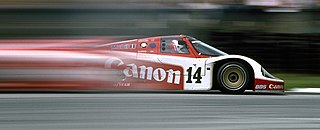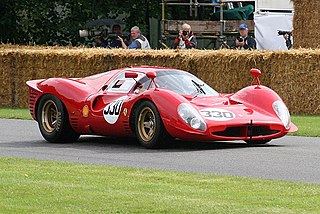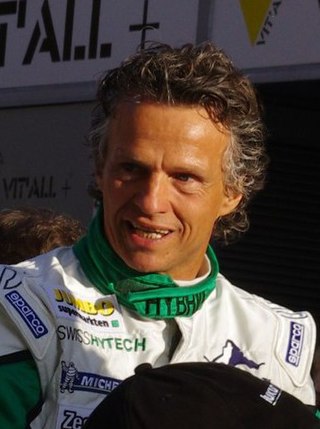The 1991 FIA Sportscar World Championship season was the 39th season of FIA World Sportscar Championship motor racing. It featured the 1991 FIA Sportscar World Championship, which was contested over an eight race series from 14 April to 28 October 28, 1991. The series was open to Group C Sportscars, with Category 1 cars complying with new 1991 Group C rules and Category 2 cars running under the pre 1991 regulations. Teo Fabi won the Drivers Championship and Silk Cut Jaguar won the Teams title.

The 1989 World Sportscar Championship season was the 37th season of FIA World Sportscar Championship motor racing. It featured the 1989 FIA World Sports Prototype Championship, which was open to Group C1 Sports Prototypes, Group C2 Sports Prototypes and IMSA GTP cars. The championship was contested over an eight round series which ran from 9 April to 29 October 1989.
The 1988 World Sportscar Championship season was the 36th season of FIA World Sportscar Championship motor racing. It featured the 1988 FIA World Sports Prototype Championship which was open to FIA Group C and Group C2 cars and to IMSA GTP, GTX, GTO and GTU cars. The championship was contested over an eleven race series which ran from 6 March to 20 November 1988.
The 1987 World Sportscar Championship season was the 35th season of FIA World Sportscar Championship racing. It featured the 1987 FIA World Sports Prototype Championship which was contested over a ten race series that commenced on 22 March and ended on 27 September. The championship was open to FIA Group C Sports Prototypes, FIA Group C2 Sports Prototypes and IMSA GTP cars. Raul Boesel won the Drivers Championship, Fermin Velez was awarded the FIA Cup for Group C2 Drivers, Silk Cut Jaguar won the Teams Championship and the FIA Cup for Group C2 Teams was awarded to Spice Engineering. Jaguar won 8 out of the 10 races and Porsche 2.
The 1986 World Sports-Prototype Championship season was the 34th season of FIA "World Sportscar Championship" motor racing. It featured the 1986 FIA World Sports Prototype Championship which was contested over a nine race series that ran from 20 April to 5 October 1986. The championship was open to Group C Sports Prototypes, Group C2 Sports Prototypes and IMSA GTP cars. The Drivers Championship was won by Derek Bell and the Teams Championship by Brun Motorsport.

The 1985 World Sportscar Championship season was the 33rd season of FIA World Sportscar Championship motor racing. It featured the 1985 World Endurance Championship which was contested over a series of races for Group C1 and Group C2 Prototypes, Group B GT Cars and IMSA GTP cars. The series ran from 14 April 1985 to 1 December 1985 and was composed of 10 races.
The 1955 World Sportscar Championship season was the third season of FIA World Sportscar Championship motor racing. It featured a series of six endurance races for sportscars, contested from 23 January to 16 October 1955.
The 1956 World Sportscar Championship was the fourth annual FIA World Sportscar Championship. It was a contested by sportscars over a series of five races from 29 January to 12 August 1956.
The 1961 World Sportscar Championship was the ninth season of FIA World Sportscar Championship motor racing. It was contested over a five race series, which ran from 25 March to 15 August 1961. The title was won by Italian manufacturer Ferrari.

The 1967 World Sportscar Championship season was the 15th season of FIA World Sportscar Championship racing. It featured the International Championship for Sports-Prototypes and the International Championship for Sports Cars. The former was open to Group 6 Sports-Prototypes and the latter to Group 4 Sports Cars. The season ran from 4 February 1967 to 3 September 1967 and comprised 14 races in total.

The 1968 World Sportscar Championship season was the 16th season of FIA World Sportscar Championship racing and featured the 1968 International Championship for Makes and the 1968 International Cup for GT Cars. The former was contested by Group 6 Sports Prototypes, Group 4 Sports Cars and Group 3 Grand Touring Cars and the later by Group 3 Grand Touring Cars only. The two titles were decided over a ten race series which ran from 3 February 1968 to 29 September 1968, but one race was only worth half points, and only the five best results were counted.

The 2003 FIA Sportscar Championship was the third season of FIA Sportscar Championship, an auto racing series regulated by the Fédération Internationale de l'Automobile and organized by the International Racing Series Ltd. It was the seventh and final season of the series dating back to the International Sports Racing Series of 1997. The series featured sports prototypes divided into two categories, SR1 and SR2, and awarded championships for drivers, constructors, and teams in both classes. The series began on 13 April 2003 and ended on 21 September 2003 after seven races in Europe.

The 2002 FIA Sportscar Championship was the second season of the FIA Sportscar Championship, an auto racing series regulated by the Fédération Internationale de l'Automobile and organized by the International Racing Series Ltd. It was the sixth season of the series dating back to the International Sports Racing Series of 1997. The series featured sports prototypes in two categories, SR1 and SR2, and awarded championships for drivers, teams, and manufacturers in each respective category. The series began on 7 April 2002 and ended on 22 September 2002 after six races held in Europe.
The 2001 FIA Sportscar Championship was the inaugural season of FIA Sportscar Championship, an auto racing series regulated by the Fédération Internationale de l'Automobile and organized by International Racing Series Ltd. The series was a continuation of the previous SportsRacing World Cup dating back to 1997. It was open to two categories of sports prototypes, SR1 and SR2, and awarded championships to drivers and teams in each category. A championship for constructors was also established for this season. It began on 8 April 2001 and ended on 16 September 2001 after eight races.

The Debora LMP296 was a Le Mans Prototype, built by Debora Automobiles in 1996 for use in the 24 Hours of Le Mans. The car was originally entered with a 2-litre turbocharged Cosworth straight-four engine, but several other engines were used in the car's three-year career. Two cars are known to have been built. In conjunction with the LMP297, the car helped Waterair Sport to the International Sports Racing Series SR2 Team's Championship in 1998. The LMP296 was updated into the LMP299 for 2000.

The 2014 FIA World Endurance Championship season was the third season of the FIA World Endurance Championship auto racing series, co-organized by the Fédération Internationale de l'Automobile (FIA) and the Automobile Club de l'Ouest (ACO). The series was open to Le Mans Prototypes and grand tourer-style racing cars from four ACO categories. World Championship titles were awarded for Le Mans Prototypes drivers and for LMP1 manufacturers, and several World Endurance Cups and Endurance Trophies were also awarded. The eight race series began in April at the Silverstone Circuit and concluded in November at the Autódromo José Carlos Pace.
The GMS Durango LMP1 was a Le Mans Prototype built for Durango by GMS in 2000. Initially fitted with a 4-litre BMW V8 engine, which was prepared by Mader, a Judd GV4 V10 was fitted in its place for the 2002 season. Durango replaced the car with their own PM 02 for the 2003 season. The GMS Durango LMP1 was not particularly successful, and had a weak gearbox; but it was able to win one race, the 2002 6 Hours of Vallelunga.
The 2016 FIA World Endurance Championship season was the fifth edition of the FIA World Endurance Championship auto racing series co-organised by the Fédération Internationale de l'Automobile (FIA) and the Automobile Club de l'Ouest (ACO). The series was open to Le Mans Prototypes and grand tourer-style racing cars meeting four ACO categories. The season began at the Silverstone Circuit in April and ended at the Bahrain International Circuit in November, and included the 84th running of the 24 Hours of Le Mans. This season was also the last WEC season for Audi Sport Team Joest as they decided not to race in the 2017 FIA World Endurance Championship Season.
The 2018–19 FIA World Endurance Championship was the seventh season of the FIA World Endurance Championship, an auto racing series co-organised by the Fédération Internationale de l'Automobile (FIA) and the Automobile Club de l'Ouest (ACO). The series is open to Le Mans Prototypes and grand tourer-style racing cars divided into four categories. The season marked the first move to a winter schedule for the championship, with the season starting at the Circuit de Spa-Francorchamps in May 2018 and concluding at the 24 Hours of Le Mans in June 2019. World championship titles were awarded for LMP drivers, GTE drivers, LMP1 teams and GTE manufacturers.
The 2021 FIA World Endurance Championship was the ninth season of the FIA World Endurance Championship, an auto racing series organised by the Fédération Internationale de l'Automobile (FIA) and the Automobile Club de l'Ouest (ACO). The series is open to prototype and grand tourer-style racing cars divided into four categories. World Championship titles were awarded to the leading manufacturers and drivers in both the prototype and grand tourer divisions.






